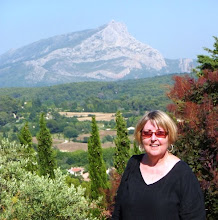My pictures are totally inadequate as usual, so here's a link to some on Google. This is what we saw as we drove.
It wasn't as crowded as I thought it might be. That's probably because it's so expensive.
The red hills coming down to the blue water were as beautiful as I remembered.
I am always amazed that the Med is as clear as it is after all these thousands of years of occupation by humans.
Red rocks are great and almost made us consider retiring to St. George, UT.
But add in blue water and you just want to look at it forever. I made this my wallpaper as soon as I loaded the pictures onto my computer.
Yeah, there is a little money in the area.
Like I said, maybe in some other life.
OK, this is the part where the joy meets the sorrow, the fun has its consequences, when I remind myself of how we are following through on our promise to the kids that they will have no inheritance beyond what they can pawn our stuff for.
The total trip cost was $10,650 for 28 days. That's about $380 per day for the 2 of us or $190 per person per day not counting airfare. That's about what Rick Steves says it should cost for a moderate to cheap trip to Europe. We usually plan on about $200 per day per person. Could we do it cheaper? Sure. Do we want to? Nope.
We got by really cheap this time because we were able to fly standby thanks to Lee, but we won't always be able to do that. Typical round trip airfares per person are about $1500 from Tucson. To us, that still isn't all that expensive.
Here's how the costs broke down into categories, from the most expensive to the least.
$3935 -- Lodging. Includes the apartments and the hotels. It includes breakfasts in the hotels when it was part of the lodging cost.
$3155 -- Food. Includes all food we had to pay for extra. About 10% of it was food bought in grocery stores. The rest was eating out. Obviously, eating more at home or picnicing would save us lots of money if we wanted or needed to do that.
$1675 -- Transportation. Includes the small fees for the flights, car rental and fuel, public transportation including trains, buses, taxis and tips and ... speeding tickets.
$1125 -- Entertainment. Includes the river cruise with the food, Le Mans, Paris museum passes for both of us and all other fees for sites, tour guides and karting. We typically do not spend as much on entertainment as others might. We probably could put a big portion of the driving costs in this category since that is entertainment for us.
$760 -- Sundries. This includes non-food items bought in places other than grocery stores, post cards and stamps, souvenirs, gifts for the dog-sitter and foreign transaction fees for credit card purchases and ATM withdrawals.
So there you have it. Not counted above is the 362 Euros I brought home with us. That's about $450 at the time we bought them. I decided to keep them rather than sell them to the one place in town I can. That way we will have some Euros in our pockets when we arrive in Amsterdam in the spring without having to buy them here before we go.





















































